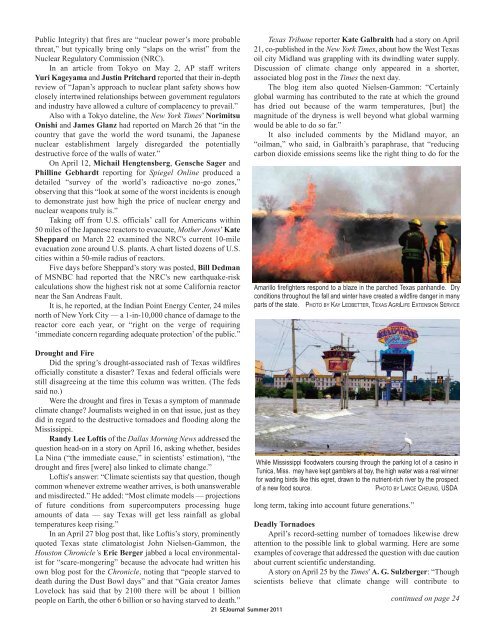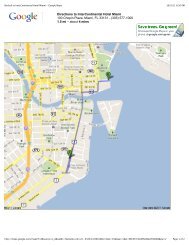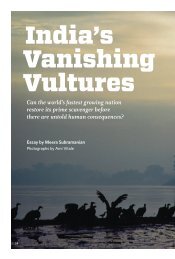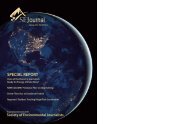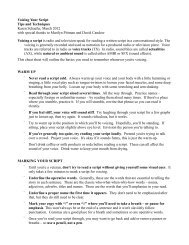ournal - Society of Environmental Journalists
ournal - Society of Environmental Journalists
ournal - Society of Environmental Journalists
- No tags were found...
You also want an ePaper? Increase the reach of your titles
YUMPU automatically turns print PDFs into web optimized ePapers that Google loves.
Public Integrity) that fires are “nuclear power’s more probablethreat,” but typically bring only “slaps on the wrist” from theNuclear Regulatory Commission (NRC).In an article from Tokyo on May 2, AP staff writersYuri Kageyama and Justin Pritchard reported that their in-depthreview <strong>of</strong> “Japan’s approach to nuclear plant safety shows howclosely intertwined relationships between government regulatorsand industry have allowed a culture <strong>of</strong> complacency to prevail.”Also with a Tokyo dateline, the New York Times’ NorimitsuOnishi and James Glanz had reported on March 26 that “in thecountry that gave the world the word tsunami, the Japanesenuclear establishment largely disregarded the potentiallydestructive force <strong>of</strong> the walls <strong>of</strong> water.”On April 12, Michail Hengtensberg, Gensche Sager andPhilline Gebhardt reporting for Spiegel Online produced adetailed “survey <strong>of</strong> the world’s radioactive no-go zones,”observing that this “look at some <strong>of</strong> the worst incidents is enoughto demonstrate just how high the price <strong>of</strong> nuclear energy andnuclear weapons truly is.”Taking <strong>of</strong>f from U.S. <strong>of</strong>ficials’ call for Americans within50 miles <strong>of</strong> the Japanese reactors to evacuate, Mother Jones’ KateSheppard on March 22 examined the NRC's current 10-mileevacuation zone around U.S. plants. A chart listed dozens <strong>of</strong> U.S.cities within a 50-mile radius <strong>of</strong> reactors.Five days before Sheppard’s story was posted, Bill Dedman<strong>of</strong> MSNBC had reported that the NRC's new earthquake-riskcalculations show the highest risk not at some California reactornear the San Andreas Fault.It is, he reported, at the Indian Point Energy Center, 24 milesnorth <strong>of</strong> New York City — a 1-in-10,000 chance <strong>of</strong> damage to thereactor core each year, or “right on the verge <strong>of</strong> requiring‘immediate concern regarding adequate protection’ <strong>of</strong> the public.”Texas Tribune reporter Kate Galbraith had a story on April21, co-published in the New York Times, about how the West Texasoil city Midland was grappling with its dwindling water supply.Discussion <strong>of</strong> climate change only appeared in a shorter,associated blog post in the Times the next day.The blog item also quoted Nielsen-Gammon: “Certainlyglobal warming has contributed to the rate at which the groundhas dried out because <strong>of</strong> the warm temperatures, [but] themagnitude <strong>of</strong> the dryness is well beyond what global warmingwould be able to do so far.”It also included comments by the Midland mayor, an“oilman,” who said, in Galbraith’s paraphrase, that “reducingcarbon dioxide emissions seems like the right thing to do for theAmarillo firefighters respond to a blaze in the parched Texas panhandle. Dryconditions throughout the fall and winter have created a wildfire danger in manyparts <strong>of</strong> the state. PHOTO BY KAY LEDBETTER, TEXAS AGRILIFE EXTENSION SERVICEDrought and FireDid the spring’s drought-associated rash <strong>of</strong> Texas wildfires<strong>of</strong>ficially constitute a disaster? Texas and federal <strong>of</strong>ficials werestill disagreeing at the time this column was written. (The fedssaid no.)Were the drought and fires in Texas a symptom <strong>of</strong> manmadeclimate change? J<strong>ournal</strong>ists weighed in on that issue, just as theydid in regard to the destructive tornadoes and flooding along theMississippi.Randy Lee L<strong>of</strong>tis <strong>of</strong> the Dallas Morning News addressed thequestion head-on in a story on April 16, asking whether, besidesLa Nina (“the immediate cause,” in scientists’ estimation), “thedrought and fires [were] also linked to climate change.”L<strong>of</strong>tis's answer: “Climate scientists say that question, thoughcommon whenever extreme weather arrives, is both unanswerableand misdirected.” He added: “Most climate models — projections<strong>of</strong> future conditions from supercomputers processing hugeamounts <strong>of</strong> data — say Texas will get less rainfall as globaltemperatures keep rising.”In an April 27 blog post that, like L<strong>of</strong>tis’s story, prominentlyquoted Texas state climatologist John Nielsen-Gammon, theHouston Chronicle’s Eric Berger jabbed a local environmentalistfor “scare-mongering” because the advocate had written hisown blog post for the Chronicle, noting that “people starved todeath during the Dust Bowl days” and that “Gaia creator JamesLovelock has said that by 2100 there will be about 1 billionpeople on Earth, the other 6 billion or so having starved to death.”21 SEJ<strong>ournal</strong> Summer 2011While Mississippi floodwaters coursing through the parking lot <strong>of</strong> a casino inTunica, Miss. may have kept gamblers at bay, the high water was a real winnerfor wading birds like this egret, drawn to the nutrient-rich river by the prospect<strong>of</strong> a new food source.PHOTO BY LANCE CHEUNG, USDAlong term, taking into account future generations.”Deadly TornadoesApril’s record-setting number <strong>of</strong> tornadoes likewise drewattention to the possible link to global warming. Here are someexamples <strong>of</strong> coverage that addressed the question with due cautionabout current scientific understanding.A story on April 25 by the Times' A. G. Sulzberger: “Thoughscientists believe that climate change will contribute tocontinued on page 24


